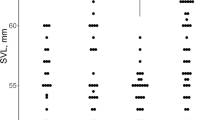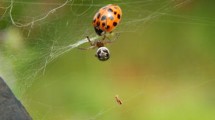Summary
The asexual geckoLepidodactylus lugubris, its sexual congenerL. sp. (Takapoto) and hybrids between the two species inhabit the atoll of Takapoto, providing a natural experiment for studying co-existence and interactions between asexual and sexual populations. The range of the sexual species is confined to one section of the lagoon beach and the trees and buildings which abut it, whereas the asexual is distributed across the whole atoll and occupies many habitats. Behavioural experiments revealed no asymmetry in levels of aggression between the two species, suggesting that the confinement ofL. sp. (Takapoto) to the lagoon beach is not due to agonistic interactions. Ecological differences among the constituent clones of the asexual species exist but cannot completely account for the broader habitat use of the asexual. Within a single habitat, one clone ofL. lugubris consumes a wider range of prey items than its sexual relative. Other studies have found that the asexuals are extremely heterozygous relative to the sexuals; we hypothesize that their broad ecological tolerance may be attributable to heterosis. The co-existence of the sexual and parthenogenetic lizards on this small island seems to be stable and may be facilitated by the specialization of the sexual taxon to beach habitats.
Similar content being viewed by others
References
Bell, G. (1982)The Masterpiece of Nature. University of California Press, Berkeley, CA.
Bolger, D.T. and Case, T.J. (1992) Intra-specific and inter-specific interference behavior among sexual and asexual geckos.Anim. Behav. 44, 21–30.
Bolger, D.T. and Case, T.J. (in press) Divergent thermal ecology of sympatric clones of the asexual gecko,Lepidodactylus lugubris oecologia.
Borror, D.J. and White, R.E. (1970)Peterson Field Guides: Insects. Houghton Mifflin Co., Boston.
Bulger, A.J. and Schultz, R.J. (1979) Heterosis and interclonal variation in thermal tolerance in unisexual fishes.Evolution 33, 848–59.
Case, T.J., Bolger, D.T. and Petren, K. (1984) Invasions and competitive displacement among house geckos in the Tropical Pacific.Ecology 75(2), 464–78.
Case, T.J. (1990) Patterns of coexistence in sexual and asexual species ofCnemidophorus lizards.Oecologia 83, 220–7.
Case, T.J. and Bender, E.A. (1981) Is recombination advantageous in fluctuating and heterogeneous environments?J. Theor. Biol. 90, 181–90
Case, T.J. and Taper, M.L. (1986) On the coexistence and coevolution of asexual and sexual predators.Evolution 40, 366–87.
Chao, L. (1990) Fitness of RNA virus decreased by Muller's Ratchet.Nature 348, 454–5.
Cuellar, O. (1984) Histocompatibility in Hawaiian and Polynesian populations of the parthenogenetic geckoLepidodactylus lugubris.Evolution 38, 176–85.
Cuellar, O. (1977) Animal parthenogenesis.Science 197, 837–43.
Dawley, R.M. and Bogart, J.P. (1989)Evolution and Ecology of Unisexual Vertebrates. Bulletin 466, New York State Museum, Albany, NY.
Dessauer, H.C. and Cole, C.J. (1989) Diversity between and within nominal forms of unisexual teiid lizards. InEvolution and ecology of unisexual vertebrates (R. M. Dawley and J.P. Bogart, eds), pp. 49–71. Bulletin 466, New York State Museum, Albany, NY.
Dye, T. and Steadman, D.W. (1990) Polynesian ancestors and their animal world.Am. Sci. 78, 207–15.
Glesener, R.R. and Tilman, D. (1978) Sexuality and the components of environmental uncertainty: clues from geographic parthenogenesis in terrestrial animals.Am. Nat. 112, 659–73.
Hamilton, W.D., Axelrod, R. and Tanese, R. (1990) Sexual reproduction as an adaptation to parasites (a review).Proc. Natl Acad. Sci. USA 87, 3566–73.
Hanley, K.A., Fisher, R.N. and Case, T.J. (in press) Higher mite infestations in sexual geckos than their asexual congeners.Evolution.
Ineich, I. (1988) Mise en evidence d'un complexe unisexue-bisexue chez le geckoLepidodactylus lugubris (Sauria, Lacertilia) en Polynesie Francaise.CR Acad. Sci, Paris 307, 271–7.
Ineich, I. (1992) La parthenogenese chez les Gekkonidae (Reptilia, Lacertilia): origine et evolution.Bull. Soc. Zool. Fr. 117, 253–66.
Ineich, I. and Ota, H. (1992) Additional remarks on the unisexual—bisexual complex of the geckoLepidodactylus lugubris in Takapoto Atoll, French Polynesia.Bull. Coll. Sci. Univ. Ryukyus 53, 31–9.
Leahy, C. (1987)Peterson First Guide to the Insects of North America. Houghton Mifflin Co., Boston.
Leuck, B.E. (1985) Comparative social behavior of bisexual and unisexual whiptail lizards (Cnemidophorus).J. Herpetol. 19, 492–506.
Levins, R. (1968)Evolution in Changing Environments: Some Theoretical Explorations. Princeton University Press, Princeton, NJ.
Lynch, M. (1984) Destabilizing hybridization, general purpose genotypes and geographic parthenogenesis.Q. Rev. Biol. 59, 257–90.
Morisita, M. (1959) Measuring interspecific association and similarity between communities.Mem. Fac. Sci. Kyushu Univ. Ser. E. (Biol) 3, 65–80.
Moritz, C. (1991) The origin and evolution of parthenogenesis inHeteronotia binoei (Gekkonidae): evidence for recent and localized origins of widespread clones.Genetics 129, 211–19.
Moritz, C., Brown, W.W., Densmore, L.D., Wright, J.W., Vyas, D., Donellan, S., Adams, M. and Baverstock, P. (1989) Genetic diversity and the dynamics of hybrid parthenogenesis inCnemidophorus (Teiidae) andHeteronotia (Gekkonidae). InEvolution and ecology of unisexual vertebrates (R.M. Dawley and J.P. Bogart, eds), pp. 87–112. Bulletin 466, New York State Museum, Albany, NY.
Moritz, C., McCallum, H., Donellan, S. and Roberts, J.D. (1991) Parasite loads in parthenogenetic and sexual lizards (Heteronotia binoei): support for the Red Queen hypothesis.Proc. R. Soc. Lond. B. 244, 145–9.
Moritz, C., Case, T.J., Bolger, D.T. and Donellan, S. (1993) Genetic diversity and the history of the Pacific island house geckos (Hemidactylus andLepidodactylus).Biol. J. Linn. Soc. 48, 113–33.
Muller, H.J. (1964) The relation of recombination to mutational advance.Mutat. Res. 1, 2–9.
Parker, E.D., Jr (1979) Ecological implications of clonal diversity in parthenogenetic morphospecies.Am. Zool. 19, 753–62.
Parker, E.D., Jr and Selander, R.K. (1976) The organization of genetic diversity in the parthenogenetic lizardCnemidophorus tesselatus.Genetics 84, 791–805
Pasteur, G., Agnese, J.F., Blanc, C.P. and Pasteur, V. (1987) Polyclony and low relative heterozygosity in a widespread unisexual vertebrate,Lepidodactylus lugubris (Sauria).Genetica 75, 71–9
Paulissen, M. A., Walker, J. M. and Cordes, J. E. (1992) Can parthenogeneticCnemidophorus laredoensis (Teiidae) coexist with its bisexual congeners?J. Herp. 26, 153–8.
Pianka, E.R. (1973) The structure of lizard communities.Annu. Rev. Ecol. Syst. 4, 53–74
Ryti, R.L. and Case, T.J. (1986) Spatial arrangement and diet overlap between colonies of desert ants.Oecologia 62, 401–4.
Saint Girons, H. and Ineich, I. (1992) Histology of the reproductive tract of hybrids between gonochoristic males and parthenogenetic females ofLepidodactylus lugubris in French Polynesia (Reptilia: Gekkonidae).J. Morphol. 212, 55–64.
Schenck, R.A. and Vrijenhoek, R.C. (1986) Spatial and temporal factors affecting coexistence among sexual and clonal forms ofPoeciliopsis.Evolution 40, 1060–70.
Shultz, R.J. (1977) Evolution and ecology of unisexual fishes.Evol. Biol. 10, 277–331.
Van Valen, L. (1973) A new evolutionary law.Evol. Theor. 1, 1–30.
Vandel, A. (1928) La parthenogenese geographique. Contribution a l'etude biologique et cytologique de la parthenogenese naturelle.Bull. Biol. France Belg. 62, 164–281.
Volobouev, V., Pasteur, G., Ineich, I. and Dutrillaux, B. (1993) Chromosomal evidence for hybrid origin of diploid parthenogenetic females from the unisexual — bisexualLepidodactylus lugubris complex (Reptilia, Gekkonidae).Cytogenet. Cell Genet. 63, 194–9.
Vrijenhoek, R.C. (1984) Ecological differentiation among clones: the frozen niche variation model. InPopulation biology and evolution (K. Wohrmann and V. Loeschke, eds), pp. 217–31. Springer-Verlag, Berlin.
Walls, J.G. (1982)Encyclopedia of Marine Invertebrates. T. F. H. Publications, Neptune, NJ.
Wright, J.W. and Lowe, C.H. (1967) Hybridization in nature between parthenogenetic and bisexual species of whiptail lizards (genusCnemidophorus).Am. Mus. Novitates 2286, 1–36.
Zar, J.H. (1984)Biostatistical Analysis. Prentice-Hall, Englewood Cliffs, NJ.
Zug, G.R. (1992)The Lizards of Fiji: Natural History and Systematics. Bernice Bishop Museum Press, Honolulu, Hawaii.
Author information
Authors and Affiliations
Rights and permissions
About this article
Cite this article
Hanley, K.A., Bolger, D.T. & Case, T.J. Comparative ecology of sexual and asexual gecko species (Lepidodactylus) in French Polynesia. Evol Ecol 8, 438–454 (1994). https://doi.org/10.1007/BF01238194
Issue Date:
DOI: https://doi.org/10.1007/BF01238194




